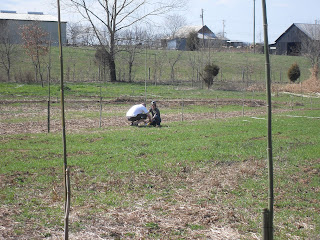Ok, months passed again and no one posted anything on our blog. (Its difficult because our internet connection has limited bandwidth, and uploading pictures takes a lot.)
But much has happened.
As always!
Melissa has setup bees, Berea and Adam are finishing a sweet cabin, Sean built a composting toilet and revived our local buying club food coop, and I just finished a new chicken house and yard. We threw a couple nice parties, hosted some work days, and have gone on night-time bike rides in the country.
Here's some pics of the new chicken house:
 This is a stationary house with a movable yard. It was important for us to establish a movable yard ("paddock") system. When chickens don't get moved around they get bored and sick. Several of our chickens caught diseases and died before we finally got this new system together.
This is a stationary house with a movable yard. It was important for us to establish a movable yard ("paddock") system. When chickens don't get moved around they get bored and sick. Several of our chickens caught diseases and died before we finally got this new system together.This structure is simpe: it is a small pole-barn, made with four cedar posts, scrap wood, scrap metal roofing, and tarps and plastic for walls. It cost about $10 to make, for 2 tarps and some staples.
In the yard, you see the red automatic waterer hanging from a bamboo tripod. The netted fence is electric...it keeps predators out and chickens in. The solar panel charges the fence. The bucket hanging near the solar panel is filled with water, and feeds the red waterer. And inside the tires is a bucket full of feed.
Side note: if you are ever looking for advice on how to keep chickens, get "How to Keep Chickens-Naturally" by Alanna Moore. It is THE book to get for naturally-minded, permaculture-minded people. I found that a lot of farmers gave terrible advice when it came to keeping and caring for chickens, and it has taken a couple years and a lot of suffering on the part of my chickens for us to get the ball rolling with a system that (hopefully) keeps them happy.
We're starting to feed our chickens a 50/50 mix of pellets and home-made mixed grains. The pellets are from Bagdhad, Kentucky, which is nice. They are not medicated, which is also nice. However, they are conventional and therefore contain genetically modified grains and probably chemical residues. So we are trying to get away from this.
Our home-made mix consists of home grown (and home-cracked) corn, sorghum, and wheat, with dried and crushed nettle and comfrey. We'll occasionally add in a different grain or herb to give the chickens some diversity. We'll also hang bouquets of dried herbs for them to free-forage and self-medicate from, and occasionally put tea of garlic, onion, dill/fennel, comfrey, nettle, sage into their water, for prevention of disease and to provide nutrients.
 Here's an inside look at the coop. In the back is the roost, which is made from cedar branches. (There's a door at the back so we can switch their entrance from one part of the yard to another while giving the other a "break" from all the chickens' traffic. The back door also allows access to clean out the bedding under the roost.) At the left are the laying boxes, which I moved from the other house.
Here's an inside look at the coop. In the back is the roost, which is made from cedar branches. (There's a door at the back so we can switch their entrance from one part of the yard to another while giving the other a "break" from all the chickens' traffic. The back door also allows access to clean out the bedding under the roost.) At the left are the laying boxes, which I moved from the other house. A view from the outside, showing how we'll access the laying boxes and harvest eggs. Its basically a hole in the wall with a heavy rubber flap that latches down or up. The walls are sheets of tarp (outside) and scrap clear plastic (inside), stapled onto the frame through a piece of used T-tape (irrigation tape), to reduce tearing. This structure is covered much like the hoop house (see last year's hoop house entry...).
A view from the outside, showing how we'll access the laying boxes and harvest eggs. Its basically a hole in the wall with a heavy rubber flap that latches down or up. The walls are sheets of tarp (outside) and scrap clear plastic (inside), stapled onto the frame through a piece of used T-tape (irrigation tape), to reduce tearing. This structure is covered much like the hoop house (see last year's hoop house entry...). Free range! Well, pretty free, anyway. They are enclosed by the electric netting, but the idea is to move them around often enough to keep them happily engaged in scratching and foraging for bugs and greens. Here they are entangled in some thornless blackberries, eating basil seeds, and dining on baby turnip greens.
Free range! Well, pretty free, anyway. They are enclosed by the electric netting, but the idea is to move them around often enough to keep them happily engaged in scratching and foraging for bugs and greens. Here they are entangled in some thornless blackberries, eating basil seeds, and dining on baby turnip greens. Yes!!!
Yes!!!












































